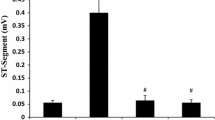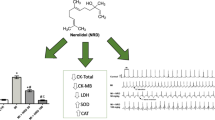Abstract
The present study aimed to investigate the cardioprotective effect of hydroxytyrosol (HT) against isoproterenol-induced myocardial infarction in rats. Male rats were randomly divided into four groups, control, isoproterenol (Isop) and pretreated animals with HT in two different doses (2 and 5 mg/kg) orally for 7 days and intoxicated with isoproterenol (Isop + HT1) and (Isop + HT2) groups. Myocardial infarction in rats was induced subcutaneously by isoproterenol (100 mg/kg, s.c.) at an interval of 24 h on 6th and 7th day. On 8th day, electrocardiographic (ECG) pattern, gravimetric and biochemical parameters were assessed. Isoproterenol exhibited changes in ECG pattern, including significant ST-segment elevation and increase in the serum troponin-T level by 317 % as compared to control rats. Moreover, cardiac injury markers (creatine kinase-MB, lactate dehydrogenase, alanine aminotransferase) underwent a notable rise in serum of infarcted animals. Else, a disturbance in lipids profile and significant increase in lipase and angiotensin-converting enzyme (ACE) activities and heart weight ratio were observed in isoproterenol group. However, pre- and co-treatment with HT (2 and 5 mg/kg) improved the myocardium injury, restored the hemodynamic function and inhibited the ACE activity that prevent cardiac hypertrophy and remodeling. Overall, these findings demonstrated that HT exerted a potent cardioprotective effect against isoproterenol-induced myocardial infarction.





Similar content being viewed by others
References
Aronow, W. S. (2006). Epidemiology, pathophysiology, prognosis, and treatment of systolic and diastolic heart failure. Cardiology in Review, 14, 108–124.
White, M. Y., Edwards, A. G., Cordwell, S. J., & Van Eyk, J. E. (2008). Mitochondria: A mirror into cellular dysfunction in heart disease. Proteomics-Clinical Applications, 2, 845–861.
Upaganlawar, A., Gandhi, H., & Balaraman, R. (2011). Isoproterenol induced myocardial infarction: Protective role of natural products. Journal of Pharmacolgical Toxicology, 6, 1–17.
Fito, M. De, La Torre, R., Farre-Albaladejo, M., Khymenetz, O., Marrugat, J., & Covas, M. (2007). Bioavailability and antioxidant effects of olive oil phenolic compounds in humans: A review. Annali dell’Istituto Superiore di Sanità, 43, 375.
Hamden, K., Allouche, N., Damak, M., & Elfeki, A. (2009). Hypoglycemic and antioxidant effects of phenolic extracts and purified hydroxytyrosol from olive mill waste in vitro and in rats. Chemical Biological Interaction, 180, 421–432.
Lee, O. H., & Lee, B. Y. (2010). Antioxidant and antimicrobial activities of individual and combined phenolics in Olea europaea leaf extract. Bioresource Technology, 101, 3751–3754.
Queenthy, S. S., & John, B. (2013). Diosmin exhibits anti-hyperlipidemic effects in isoproterenol induced myocardial infracted rats. European Journal of Pharmacology, 718, 213–218.
Friedewal, W. T., Levy, R. I., & Fredrickson, D. S. (1972). Estimation of the concentration of low-density lipoprotein cholesterol in plasma, without use of the preparative ultracentrifuge. Clinical Chemistry, 18, 499–502.
Allouche, N., Fki, I., & Sayadi, S. (2004). Toward a high yield recovery of antioxidants and purified hydroxytyrosol from olive mill wastewaters. Journal of Agriculture and Food Chemistry, 52, 267–273.
Granados-Principal, S., Quiles, J. L., Ramirez-Tortosa, C. L., Sanchez-Rovira, P., & Ramirez-Tortosa, M. C. (2010). Hydroxytyrosol: From laboratory investigations to future clinical trials. Nutrition Reviews, 68, 191–206.
O’Dowd, Y., Driss, F., Dang, P. M., Elbim, C., Gougerot-Pocidalo, M. A., Pasquier, C., et al. (2004). Antioxidant effect of hydroxytyrosol, a polyphenol from olive oil: Scavenging of hydrogen peroxide but not superoxide anion produced by human neutrophils. Biochemical Pharmacology, 68, 2003–2008.
González-Correa, J. A., Navas, M. D., Lopez-Villodres, J. A., Trujillo, M., Espartero, J. L., & De La Cruz, J. P. (2008). Neuroprotective effect of hydroxytyrosol and hydroxytyrosol acetate in rat brain slices subjected to hypoxia-reoxygenation. Neuroscience Letters, 446, 143–146.
Vázquez-Velasco, M. Esperanza, Díaz, L., Lucas, R., Gómez-Martínez, S., Bastida, S., Marcos, A., & Sánchez-Muniz, F. J. (2011). Effects of hydroxytyrosol-enriched sunflower oil consumption on CVD risk factors. British Journal of Nutrition, 105, 1448–1452.
Cabrerizo, S. La, Cruz, D., Pedro, J., López-Villodres, J. A., Muñoz-Marín, J., Guerrero, A., & González-Correa, J. A. (2013). Role of the inhibition of oxidative stress and inflammatory mediators in the neuroprotective effects of hydroxytyrosol in rat brain slices subjected to hypoxia reoxygenation. Journal of Nutritional Biochemistry, 24, 2152–2157.
Kannan, M. M., & Quine, S. D. (2011). Ellagic acid ameliorates isoproterenol induced oxidative stress: Evidence from electrocardiological, biochemical and histological study. European Journal of Pharmacology, 659, 45–52.
Kannan, M. M., & Quine, D. S. (2013). Ellagic acid inhibits cardiac arrhythmias, hypertrophy and hyperlipidaemia during myocardial infarction in rats. Metabolism, 62, 52–61.
Whalen, E. J., & Lewis, S. J. (1999). In vivo evidence that isoproterenol may increase heart rate in the rat by mechanisms in addition to activation of cardiac β1-or β2-adrenoceptors. European Journal of Pharmacology, 382, 207–210.
Granados-Principal, S., El-Azem, N., Pamplona, R., Ramirez-Tortosa, C., Pulido-Moran, M., Vera-Ramirez, L., et al. (2014). Hydroxytyrosol ameliorates oxidative stress and mitochondrial dysfunction in doxorubicin-induced cardiotoxicity in rats with breast cancer. Biochemical Pharmacology, 90, 25–33.
O’Brien, P. J., Smith, D. C., Knechtel, T. J., Marchak, M. A., Pruimboom-Brees, I., Brees, D. J., et al. (2006). Cardiac troponin I is a sensitive, specific biomarker of cardiac injury in laboratory animals. Laboratory Animals, 40, 153–171.
Evran, B., Karpuzoğlu, H., Develi, S., Kalaz, E. B., Soluk-Tekkeşin, M., Olgaç, V., & Uysal, M. (2014). Effects of carnosine on prooxidant–antioxidant status in heart tissue, plasma and erythrocytes of rats with isoproterenol-induced myocardial infarction. Pharmacological Reports, 66, 81–86.
Radhiga, T., Rajamanickam, C., Sundaresan, A., Ezhumalai, M., & Pugalendi, K. V. (2012). Effect of ursolic acid treatment on apoptosis and DNA damage in isoproterenol induced myocardial infarction. Biochimie, 94, 1135–1142.
Kumaran, K. S., & Prince, P. S. M. (2010). Protective effect of caffeic acid on cardiac markers and lipid peroxide metabolism in cardiotoxic rats: an in vivo and in vitro study. Metabolism-Clinical and Experimental, 59, 1172–1180.
Leroith, D. (2007). Dyslipidemia and glucose dysregulation in over weight and obese patients. Clinical Cornerstone, 8, 38–52.
Mnafgui, K., Derbali, A., Sayadi, S., Gharsallah, N., Elfeki, A., & Allouche, N. (2014). Anti-obesity and cardioprotective effects of cinnamic acid in high fat diet-induced obese rats. Journal of Food Science and Technology,. doi:10.1007/s13197-014-1488-2.
Fki, I., Sahnoun, Z., & Sayadi, S. (2007). Hypocholesterolemic effects of phenolic extracts and purified hydroxytyrosol recovered from olive mill wastewater in rats fed a cholesterol-rich diet. Journal of Agriculture and Food Chemistry, 55, 624–631.
Jemai, H. El, Feki, A., & Sayadi, S. (2009). Antidiabetic and antioxidant effects of hydroxytyrosol and oleuropein from olive leaves in alloxan-diabetic rats. Journal of Agriculture and Food Chemistry, 57, 8798–8804.
Schieffer, B., Wirger, A., Meybrunn, M., Seitz, S., Holtz, J., Riede, U. N., & Drexler, H. (1994). Comparative effects of chronic angiotensin-converting enzyme inhibition and angiotensin II type 1 receptor blockade on cardiac remodeling after myocardial infarction in the rat. Circulation, 89, 2273–2282.
Borghi, C., Bacchelli, S., Esposti, D. D., & Ambrosioni, E. (2006). Effects of early angiotensin-converting enzyme inhibition in patients with non–ST-elevation acute anterior myocardial infarction. American Heart Journal, 152, 470–477.
Teyssedou, A. (2007). LES IEC dans le post-infarctus: gros plan sur le zofénopril. Annales de Cardiologie et d Angéiologie, 56, 137–144.
Lindpaintner, K., Lu, W., Niedermayer, N., Schieffer, B., Just, H., Ganten, D., & Drexler, H. (1993). Selective activation of cardiac angiotensinogen expression in postinfarction ventricular remodeling in the rat. Journal of Molecular and Cellular Cardiology, 25, 133–145.
Acknowledgments
This research was supported by the Tunisian Ministry of Higher Education and Scientific Research and the Tunisian Ministry of Public Health. Authors wish to thank Mrs. Sadok Slema, Mbarek Nasri and Chedly Tmar for their assistance and cooperation.
Conflict of interests
The authors declare no conflict of interest.
Author information
Authors and Affiliations
Corresponding author
Additional information
Raouf Hajji and Fatma Derbali have contributed equally to this work.
Rights and permissions
About this article
Cite this article
Mnafgui, K., Hajji, R., Derbali, F. et al. Protective Effect of Hydroxytyrosol Against Cardiac Remodeling After Isoproterenol-Induced Myocardial Infarction in Rat. Cardiovasc Toxicol 16, 147–155 (2016). https://doi.org/10.1007/s12012-015-9323-1
Published:
Issue Date:
DOI: https://doi.org/10.1007/s12012-015-9323-1




